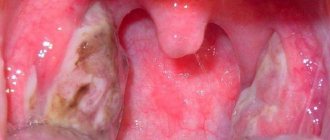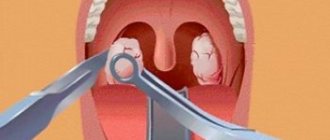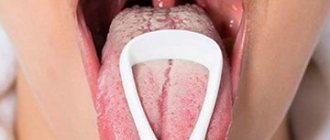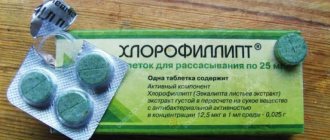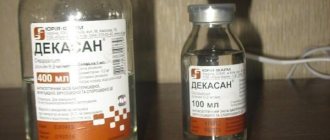Uvulitis is an acute inflammatory pathology of the uvula of infectious-allergic etiology, occurring suddenly and manifested by painful sensations, the feeling of a foreign object in the throat, and respiratory dysfunction. Cough does not bring relief, but only worsens the well-being of patients. They develop dysphonia, dysphagia, and severe pain when moving the tongue.
With this pathology, the uvula swells, increases in size, hurts, swells, becomes red or bluish, and becomes covered with a film. Often light spots or plaque appear on its surface. It hangs down to the root of the tongue, interferes and causes vomiting.
The uvula is a fairly small organ that cannot become a source of serious problems. In severe cases, inflammation develops so severely that patients have difficulty breathing.
The uvula is the final part of the soft palate, located in the basal part of the tongue. It is a smooth muscle organ, covered on top with a mucous membrane and penetrated by many capillaries, arterioles and venules. Swelling of the uvula in the throat and its redness develops with infectious tonsillitis, pharyngitis, and stomatitis.
The uvula performs a number of specific functions:
- Participates in sound production
- Prevents pieces of food from entering the larynx,
- Provides redistribution of air flows,
- Participates in the process of vomiting and coughing,
- Warms the atmospheric air.
Inflammation of the uvula in the throat can lead to disruption of any of these functions.
The most common cause of uvulitis is infection. Bacteria, viruses, fungi, protozoa, penetrating into the body from the external environment or from chronic foci present in the body, lead to the development of a pathological process, manifested by 5 signs: pain, swelling, hyperemia, hyperthermia, dysfunction.
Diseases in which uvulitis often occurs:
- Infectious diseases of the oral cavity and nasopharynx,
- Dental diseases,
- Acute or chronic tonsillitis, pharyngitis,
- Purulent inflammation of the subcutaneous fatty tissue of the neck,
- Injuries and burns of the oral cavity,
- Allergy,
- Benign and malignant tumors of the soft palate.
The uvula becomes inflamed due to the following provoking factors: excessive alcohol consumption, long-term use of certain medications, local hypothermia, snoring, rupture of blood vessels in the uvula, smoking.
Symptoms
At the initial stage of the disease, swelling and other signs of inflammation are insignificant. Respiratory dysfunction does not develop in patients. Clinically, uvulitis is manifested by a feeling of a foreign object in the throat, a change in voice, and discomfort when swallowing and speaking. The tongue in the throat enlarges and swells slightly. The general condition of the patients remains satisfactory.
Moderate and severe uvulitis manifests itself with more pronounced clinical symptoms. The patient experiences:
- Hyperemia and swelling of the uvula,
- Hanging it to the root of the tongue,
- Swelling and tenderness of the soft palate,
- Fever,
- Weakness, myalgia, arthralgia,
- Dysphonia,
- Hypersalivation,
- The urge to vomit
- Rhinitis.
photo of an inflamed tongue in the throat
Symptoms of uvulitis occur when eating food, coughing or sneezing. Persons who have undergone adenoidectomy and tonsillectomy are most susceptible to developing the disease.
The inflamed uvula swells in the throat, becomes red and increases significantly in size. The uvula appears white when coated. In the absence of timely medical care, it can block the airways, which will lead to the development of asphyxia.
Diagnosis of uvulitis involves conducting a pharyngoscopy examination. In patients, the uvula is enlarged, swollen, and hyperemic. If it reaches the root of the tongue, a gag reflex occurs. In severe cases, the tip of the tongue becomes bluish, becomes covered with a false film, or becomes ulcerated.
Treatment of uvulitis consists of eliminating the underlying disease, which directly caused it. Complex therapy of pathology will help get rid of the main clinical signs and restore the condition of patients.
General recommendations from specialists that should be followed when treating uvulitis:
- Sufficient drinking regimen, restoring water and electrolyte balance,
- Maintaining personal hygiene rules
- Airing the room
- Wet cleaning,
- Air humidification,
- Using separate utensils
- Eliminating foods that irritate the throat from the diet
- Rejection of bad habits.
Traditional medicine
Uvulitis is usually treated by otolaryngologists. The infectious form of the pathology requires a course of antibiotic therapy, as well as local exposure - rinsing the mouth with a decoction of chamomile and sage, and using an antiseptic spray.
Antibiotics are prescribed after analyzing the oral fluid for microflora, determining the type of pathogen and its sensitivity. Broad-spectrum drugs from the group of fluoroquinolones, cephalosporins, macrolides - Ciprofloxacin, Azithromycin, Ceftazidime - have a positive therapeutic effect.
Treatment of allergic uvulitis involves the use of:
- Antihistamines - “Diazolin”, “Suprastin”, “Cetrin”.
- Diuretics - Furosemide, Veroshpiron, Hypothiazide.
- Glucocorticosteroids for difficulty breathing - Prednisolone, Hydrocortisone, Betamethasone.
Swelling of the uvula and soft palate in advanced cases requires tracheostomy.
Among the most effective physiotherapeutic procedures used to treat uveitis are: UHF therapy, phototherapy, electrophoresis, acupuncture, magnetic therapy, galvanotherapy, ultraviolet irradiation, quartz.
ethnoscience
To treat uvulitis, mouth rinses with decoctions of medicinal herbs, inhalations, and infusions for oral administration are used.
The following products are used to rinse your mouth:
- Viburnum decoction is obtained from dried fruits, which are boiled in a water bath for half an hour.
- Garlic infusion is prepared by chopping garlic and adding boiled water to the resulting mass. Leave the product for 5 hours and use it as directed.
- Raspberry leaves and stems are brewed for half an hour in a glass of boiling water.
- St. John's wort, sage and thyme are infused in vodka for 7 days and taken forty drops orally.
- Pour boiling water over the onion peel and leave for 4 hours, then gargle.
Inhalations are made using essential oils of eucalyptus, cedar, and fir. A decoction of pine buds and thyme infusion are combined, eucalyptus oil is added and inhalation is carried out with the resulting product.
Rosehip infusion has a pronounced diuretic effect. Anise infusion and linden tea are suitable for oral use for uvulitis.
Drug treatment
Treatment of these formations depends on their shape and type.
White
Blisters with a whitish coating are treated as follows:
- prescribe a course of antibiotics;
- prescribe probiotics and prebiotics to the patient;
- it is recommended to use antiviral drugs, which are prescribed in case of viral blisters;
- antihistamines are prescribed to relieve swelling and eliminate the inflammatory process;
- antipyretic medications are taken when the body temperature rises above 38 degrees;
- painkillers and anti-inflammatory drugs are used.
Reds
Red blisters are treated a little differently:
- medications are prescribed to combat viruses;
- ointments with a similar effect are used;
- use immunostimulating agents;
- treat the affected areas with anesthetic gels.
Even more interesting:
Effective injections for prostatitis
Apple cider vinegar for dandruff reviews
Treatment of stomatitis requires strict adherence to oral cleanliness. During the disease, it is necessary to avoid additional trauma to the mucous surface of the oral cavity.
Prohibited procedures
If blisters have already appeared, then the following measures are strictly forbidden:
- warm the affected areas. You should avoid compresses, hot baths and all kinds of hot inhalations. Such actions can only accelerate the spread of infection;
- get rid of the bubbles yourself. You can injure the mucous membrane of the oropharynx and introduce an infection there;
- treat blisters with alcohol. Alcohol solutions will only worsen the situation and can lead to complex burns of the mucous membrane.
Rules for treating blisters on the back of the throat
During the treatment of the disease, you need to follow several rules that are universal and suitable for any form of the disease:
- bed rest for the entire period of the treatment process. It’s better to take sick leave at work and rest at home in complete peace for at least three days;
- drink plenty of fluids. Drinking plenty of fluids will remove toxins, waste and waste from bacteria and viruses from the entire body.
After basic drug treatment, the patient is prescribed immunostrengthening therapy, which includes a number of vitamin complexes.
But before starting the treatment process, the patient must be shown to the doctor in any case and without fail.
What should I do if I have a similar but different question?
If you did not find the information you need among the answers to this question, or your problem is slightly different from the one presented, try asking an additional question to the doctor on the same page, if it is on the topic of the main question. You can also ask a new question, and after a while our doctors will answer it. It's free. You can also search for the information you need in similar questions on this page or through the site search page. We will be very grateful if you recommend us to your friends on social networks.
Medical portal 03online.com
provides medical consultations via correspondence with doctors on the website. Here you get answers from real practitioners in your field. At the moment, on the site you can get a consultation in 45 areas: an allergist, venereologist, gastroenterologist, hematologist, genetics, gynecologist, homeopath, dermatologist, children's gynecologist, children's neurologist, children's surgeon, children's endocrinologist, nutritionist, immunologist, cardiologist, cardiologist, cosmetologist, cosmetologist, cosmetologist speech therapist, ENT specialist, mammologist, medical lawyer, narcologist, neurologist, neurosurgeon, nephrologist, oncologist, urologist, orthopedist-traumatologist, ophthalmologist, pediatrician, plastic surgeon, proctologist, psychiatrist, psychologist, pulmonologist, rheumatologist, sexologist-andrologist , dentist, urologist, pharmacist, herbalist, phlebologist, surgeon, endocrinologist.
We answer 95.72% of questions.
An ulcer in the throat causes pain, burning, soreness, and coughing. Damage to the mucous membrane of the pharynx, pharynx and larynx can be caused by various reasons and are observed in patients of different ages: from infants to the elderly.
Determining what caused the formation of sores in the throat can be very difficult. In addition, sometimes they are located in such a way that they cannot be seen without special mirrors. You need the help of a doctor who will diagnose and, based on the results obtained, prescribe effective treatment.
Throat ulcers can be a sign of many diseases. Most often they are formed with purulent tonsillitis, tonsillitis, pharyngitis, pharyngomycosis and stomatitis. In addition, damage to the mucous membrane can develop due to regular strain on the vocal cords during loud speech. They are localized inside the larynx, an organ that is involved in sound production. Their common name is contact ulcers.
The causes of throat ulcers are:
damage to the mucous membrane by a foreign body (seed husks, fish bone, etc.); irritating effect of citrus juice, spicy and seasoned foods; excessive consumption of sweets; diseases of the digestive tract; vitamin deficiency; oncological tumors; neglect of personal hygiene rules; weak immunity; inhalation of tobacco smoke by a non-smoker (passive smoking); hormonal imbalances; allergic manifestations; stressful situations. Types of ulcers
Ulcers in the throat most often come in two types: leukoplakia and manifestations of stomatitis. In the first case, keratinization of the integumentary epithelial layer of the mucous membrane occurs. This often happens when exposed to tobacco smoke. White plaques appear on the pharynx and larynx. They may not cause any discomfort and are detected only when located on the vocal folds - loss of voice occurs and hoarseness appears. In 3 out of 100 patients, leukoplakias turn into cancerous tumors.
With stomatitis, the mucous membrane is damaged due to the proliferation of fungi, bacteria, viruses, allergens and as a result of injury. Ulcers can be represented by erosions, small cell hemorrhages, vesicular or curdled rashes.
The symptoms of a throat ulcer largely depend on the causes that caused it. But the common thing is discomfort at the site of damage to the mucous membrane.
The most common manifestations that develop are:
whitish, grayish and yellowish ulcers on the tonsils; the mucous membrane of the larynx and pharynx is inflamed and hyperemic; the throat hurts, itchy; during swallowing, unpleasant sensations appear, from tingling to painful; pain spreads to the nose and ears; eyes turn red; dry throat develops; itching, pinching, tingling and other unpleasant sensations appear in the pharynx and larynx; appetite decreases, the desire to eat food disappears due to discomfort; hearing problems gradually develop; snoring becomes more frequent; general weakness, fatigue, and irritability appear.
If symptoms persist for more than a week, then medical help is indispensable. They may be a sign of an infection that requires antibiotics. With proper treatment, the discomfort goes away within the first two days: pain and itching disappear, inflammation decreases.
If ulcers develop in the throat or you suspect them, you should consult a doctor as soon as possible: an otolaryngologist or a therapist. He will make a diagnosis and prescribe adequate treatment.
The specialist performs the following diagnostic procedures:
laryngoscopy - examination of the larynx and pharynx using a special instrument with mirrors and lighting (sometimes a reflector is used that reflects the light of a lamp); endoscopy (pharyngoscopy and indirect laryngoscopy) – examination of the mucous membrane of the throat using a flexible tube with a camera and a flashlight, the image is displayed on the monitor; puncture - using a thin needle, the doctor punctures the abscess and collects pus for subsequent laboratory testing, which helps determine the type of pathogen; biopsy – collection of particles of damaged tissue for laboratory analysis (for example, if cancer is suspected); Ultrasound, X-ray and CT scan of the neck are not always required. Treatment
Treatment of throat ulcers includes taking medications orally, using local remedies for treating the mucous membrane and rinsing, and following a diet. The doctor determines which medications are needed after receiving the examination results and making a diagnosis.
The following drugs can be prescribed for internal and local use:
antihistamines (Suprastin, Tavegil, Diphenhydramine); antibiotics (Doxycillin, Erythromycin, Amoxicillin); antiviral (Acyclovir); antifungal (Levorin, Nystatin, Pimafucin); stimulating healing (Solcoseryl, Karotolin, Vinilin); anesthetic, anti-inflammatory (Lidocaine, Benzocaine, Kalgel, Kamistad); antiseptic (Lugol, hydrogen peroxide for treating ulcers with a gauze swab).
Gargling plays an important role in the treatment of throat ulcers. They can be performed using Chlorhexidine, decoctions of sage, chamomile, St. John's wort, soda solution, Furacilin. The procedure must be carried out after each meal.
In order for ulcers in the throat to heal faster, you need to adjust your diet: exclude all foods that can increase inflammation and irritation of the mucous membrane (sour, spicy, hot, hard and capable of causing mechanical injury). It is worth introducing foods high in vitamins E, B12, folic acid and iron into your diet: carrot puree, vegetable oils, oatmeal, broccoli, poultry, liver, beef, cheese, cottage cheese.
In some cases, treatment of throat ulcers is performed surgically. Surgery may be necessary when conservative methods do not bring the expected results. The doctor opens the abscess and removes the pus, clearing the mucous membrane of plaque. All this helps speed up the healing process.
You can prevent the formation of ulcers in the throat by following a few simple recommendations:
avoid mechanical damage to the mucous membrane (use fish, seeds, hard and tough foods with caution); adhere to a balanced diet with sufficient amounts of vitamins A, B12, C, E, folic acid and iron; limit your consumption of sweets; strengthen the immune system: toughen up, play sports, take walks, etc.; observe personal hygiene rules to avoid infection.
An ulcer in the throat can be caused by many diseases: sore throat, stomatitis, pharyngitis, allergies and others. It can also be the result of mechanical damage, exposure to aggressive substances or temperatures, or overstrain of the vocal cords as a result of long loud speech. To determine its cause, a number of diagnostic procedures are prescribed.
After making a diagnosis, the doctor selects medications to eliminate sores in the throat. If they are ineffective, an operation is performed (opening the abscesses). There is no point in delaying treatment, since seemingly harmless damage to the mucous membrane can be a source of infection that can spread to neighboring organs, or tissue that can degenerate into a malignant tumor.
Author: Olga Khanova, doctor, especially for Moylor.ru
Useful video about pharyngitis
Ulcerative necrotic tonsillitis
This type of inflammatory lesion of the tonsils, also called Simanovsky-Plaut-Vincent angina, is relatively rare. A characteristic symptom of this disease is the formation of an ulceration on the surface of one of the tonsils, which has a dirty-grayish bottom.
The cause that causes the development of this pathology is the common spirochete of the oral cavity and Vincent's fusiform bacillus. The listed microorganisms are part of the normal microflora that lives on the mucous membranes of our body. They are considered opportunistic and usually do not lead to the development of clinically advanced diseases. In order for them to provoke the onset of the disease and cause the appearance of ulcerations in the throat, exposure to predisposing factors is necessary:
- decreased intensity of the immune system;
- physical exhaustion of the body;
- vitamin deficiency;
- a sharp decrease in protein consumption;
- serious chronic pathologies of an autoimmune nature;
- infectious lesions of the teeth, oral cavity, pharynx and larynx.
The necrotic process with the formation of an ulcer in this type of sore throat primarily affects one of the tonsils. This tonsil increases significantly in size and becomes loose. On the surface there is redness and a yellowish-gray coating with an unpleasant odor. This plaque is quite easily separated from the tissues, revealing underneath itself, in fact, an ulcer with torn edges and bleeding walls.
In addition to the formation of ulcerations on the mucous membrane, this disease manifests itself:
- discomfort in the pharynx with difficulty swallowing;
- sensation of a foreign body in the throat;
- inflammation and enlargement of nearby lymph nodes on the affected side;
- soreness of the lymph nodes;
- the appearance of an unpleasant odor;
- increased salivation;
- spread of inflammatory lesions and ulcerations to surrounding tissues;
- stomatitis.
Important! Ulcerative necrotizing tonsillitis is characterized by serious damage to the tonsils, which, however, is combined with a satisfactory general condition of the patient. This discrepancy between the severity of general and local symptoms is a characteristic sign of this disease.
Reasons why ulcers occur
Determining the reasons why ulcers appear on the tongue and throat is very important, since this determines how quickly and how successfully the treatment method will be selected. In addition, not all of the causes are safe for human health; some diseases require serious and prompt intervention.
The causes of ulcers are usually considered to be:
mechanical trauma to the mucous membrane; chemical or radiation damage; unbalanced diet; allergic reactions; stress; bad habits; poor quality or incorrectly installed dental materials; hereditary predisposition; hormonal imbalances; problems with blood supply to tissues; fungi, bacteria or viruses.
Also, oral hygiene has a significant influence on the development and appearance of ulcers, namely its regularity, thoroughness and the quality of the products used for these purposes.
Herpangina
With herpangina, caused by damage to the mucous membrane of the throat by the Coxsackie virus, whitish ulcerations form on the surface of the tissue, usually not exceeding 2 mm in diameter. They are localized mainly along the back wall of the pharynx, on the tonsils, on the uvula, palate and the palatine arches surrounding it. This type of sore occurs most often in childhood. At first, the ulcers have the appearance of papules or small blisters. But 3-4 days after their appearance, these elements transform into ulcerative lesions.
In addition to the appearance of ulcerations in the throat, herpetic sore throat is characterized by:
- acute onset of the disease with a sharp increase in body temperature;
- sore throat;
- swallowing disorders;
- deterioration of the patient's general condition;
- enlargement of regional lymph nodes;
- inflammatory processes in the pharynx;
- sometimes abdominal pain, nausea and vomiting.
Treatment of herpangina consists of disinfectant and cleansing rinses. If your throat hurts badly, it is recommended to use sprays with an anesthetic effect. High temperatures must be brought down with antipyretics. The patient is advised to drink plenty of fluids, intensively take vitamins and a gentle diet. Antibiotic therapy is prescribed only when a bacterial infection is associated. If it was possible to prevent the development of complications, then the outcome of herpetic sore throat is the complete recovery of the patient.
Magnifying glass for symptoms
In most cases, people are in no hurry to see a doctor if they find one or more ulcers in their throat or tongue. The appearance of these elements is attributed to sore throat and stomatitis, without going into details, and using self-medication, which often only aggravates the disease.
To protect yourself from undesirable consequences and complications, let us consider in more detail the cases in which an ulcer can form in the throat on the tongue and in other parts of the throat and tongue:
Trauma to the mucous membrane can be mechanical, thermal, chemical and radiation. This means that this list includes the following situations: bites; blows; damage from a sharp object; during endoscopic examinations; injuries from sharp edges of destroyed teeth; dental procedures; bad habits; malocclusion; dehydration and vitamin deficiency; use of high concentrations of medications; getting household chemicals, vinegar, acids or alkalis into the mouth and throat; injuries from radiation therapy.
In the case of mechanical injuries, erosions and ulcers coincide in shape with the traumatic object, can be of different sizes and depths, with edges slightly raised above the surface, swollen and somewhat hyperemic. Ulcers cause pain when eating, swallowing, talking. In some cases, there may be an increase in body temperature and signs of regional lymphadenitis.
Depending on the substance with which the chemical burn was caused, the affected area may have clear or blurred boundaries, but in any case it is accompanied by severe swelling and redness, ulcers with fibrinous films, the removal of which causes bleeding. In addition, swallowing and eating causes severe pain, salivation increases, and body temperature increases.
Aphthous stomatitis - causes a violation of the integrity of the mucous membrane through the appearance of single or multiple aphthae (erosions and ulcers). The disease is more common in women, and according to statistics, more than 20% of the world's population have experienced this disease at least once. Aphthous stomatitis manifests itself as one or more aphthae, which can be found on the mucous membrane of the cheeks, lips or tongue. Body temperature rises, chills and headache appear, and sometimes the occipital and cervical lymph nodes become enlarged. The size of the ulcers usually does not exceed 5 mm, they are sharply painful, oval or round in shape with a yellowish coating. Pain from canker sores interferes with the normal consumption of food and drinks, and also causes discomfort when speaking. The ulcer heals a few weeks after the first manifestations of the disease, without scar formation.
Allergic stomatitis occurs when an allergen enters the body and settles on the oral mucosa. Bubbles appear in the oral cavity, which burst and turn into ulcers; in some cases, the ulcers merge with each other and form quite large lesions. Ulcers can be localized on the mucous membranes of the lips, cheeks, tongue, palate and gums. There is also some swelling in the mouth, which makes swallowing difficult and causes biting of the tongue or cheeks. A tongue ulcer due to mushrooms in the throat can occur against the background of herpetic stomatitis. Infection occurs by contact, hematogenous or airborne droplets. The disease is accompanied by weakness, lethargy and drowsiness, headache and loss of appetite. Body temperature can reach 40°C and cause vomiting and convulsions. The oral mucosa is swollen, and a white coating forms on the cheeks and tongue. A few days after the onset of the disease, multiple rashes with cloudy liquid contents can be noticed on the mucous membrane of the cheeks, tongue and tonsils. After the blisters burst, an erosive surface is exposed, which does not heal for a long time, gradually transforming into an ulcer with a film or a whitish coating. The disease is accompanied by a burning sensation and severe pain, swallowing and eating cause pain, and in the severe stage of the disease there is bad breath and the spread of blisters to the skin of the ears, hands and face. Necrotizing recurrent periadenitis or Setton's aphthae is manifested by compactions on the submucosal basis, in place of which ulcers subsequently form with compacted edges and an inflammatory infiltrate. These ulcers are incredibly painful and can occur on the sides of the tongue, lips or cheeks. The ulcers do not scar for several months, and the course of the disease can last for more than one year. Patients often complain of burning and pain in places where ulcers will later be found; it is typical that with this disease no more than 2-3 ulcers occur. Contact ulcers of the larynx occur on the mucous membrane that covers the cartilage to which the vocal folds are attached. Such ulcers occur from vocal strain, chronic cough, smoking and irritation from the acidic contents of the stomach. Patients note mild pain when speaking and during swallowing, hoarseness of varying degrees of severity. Ulcerative-necrotic tonsillitis occurs when the opportunistic flora of the oral cavity is activated, and develops against the background of decreased immunity, exhaustion of the body, or protein deficiency. An important role in the development of the disease is played by the presence of carious teeth in the oral cavity or prolonged smoking.
The disease begins with discomfort during swallowing and deterioration in general well-being, followed by a slight increase in temperature and bad breath. The tonsils are covered with white or gray-yellow films; they are soft in consistency, with a hyperemic rim and are easily removed. When the film is removed, an ulcerative surface is revealed that bleeds.
Important! At the beginning of the disease, the ulcers are superficial, but as it progresses, the tissue defect becomes deeper.
Herpangina is transmitted by airborne droplets or contact, and most often occurs in children aged 3-10 years. The incubation period can last up to 14 days, after which the disease manifests itself with the following symptoms: weakness and malaise, high body temperature (up to 40°C), muscle and back pain. Vomiting, headache and diarrhea are quite common. Naturally, with herpetic sore throat, patients feel a sore throat, salivation becomes more profuse, and a runny nose and cough appear. Within a few days after the incubation period, you can notice the appearance of small papules on the mucous membrane of the tonsils, uvula and palate, which gradually transform into vesicles - bubbles about 5 mm in size with serous contents. After a couple of days, the vesicles open and become gray-white ulcers with a red rim. In some cases, ulcers can merge with each other, which leads to more serious defects in the mucous membrane. Oral tuberculosis is a consequence of pulmonary or bone tuberculosis. Mycobacterium tuberculosis invades the oral mucosa through the blood or lymph flow from the primary focus of tuberculosis. Oral tuberculosis can manifest itself in several ways. For example, with miliary ulcerative tuberculosis, ulcers form on the buccal mucosa, soft palate, back and lateral surfaces of the tongue, and floor of the mouth. Initially, small nodules of a gray-red hue are formed, which soon become microabscesses and open on their own, forming small, multiple and very painful ulcers. Such ulcers quickly merge with each other, forming lesions up to 3 cm in diameter, irregular in shape with corroded edges. Other symptoms include sudden weight loss, increased sweating, shortness of breath, and increased body temperature. Syphilis of the mouth or throat occurs when infected with Treponema pallidum. The larynx, pharynx, tonsils, tongue, soft or hard palate, lips or cheeks may be affected. In the place where Treponema pallidum penetrates, a hard chancre is formed, accompanied by an increase in regional lymph nodes. Usually the chancre is single, up to 10 mm in size, but in some cases 2 or 3 chancre may form.
Its development begins with redness and thickening, after which the central part undergoes necrosis with the formation of an ulcer or oval-shaped erosion. With secondary syphilis, many small papules form on the oral mucosa, which open and expose an erosive or ulcerative surface.
Such papules are not accompanied by any subjective sensations. When the disease passes into the tertiary stage, gumma forms, which is a painless node measuring about 1.5 cm.
After the center of the gumma is opened, a large crater-shaped ulcer appears in its place, with a necrotic core located in the center. The ulcer heals within 3-4 months, leaving behind a retracted star-shaped scar.
Sore throat and tongue ulcers most often indicate various forms of sore throat.
Syphilis of the throat: damage to the larynx
The larynx is the upper part of the respiratory system and the organ of voice production. It is located in the front of the neck, where the Adam's apple (thyroid cartilage) is formed.
Damage to the larynx in secondary syphilis
With secondary syphilis, the appearance of roseola or papular rashes on the vocal cords is noted, which leads to syphilitic dysphonia (violation of the sound of the voice) or aphonia (complete absence of voice). Diffuse erythema is similar to catarrhal laryngitis. Since secondary syphilides in the larynx do not show themselves for a long time, the disease goes unnoticed at first, and the patient all this time poses a danger to others.
Damage to the larynx in tertiary syphilis
- During the period of tertiary syphilis, gummas may appear in the larynx. When they disintegrate and a secondary infection occurs, inflammatory swelling appears, which leads to difficulty breathing. The ulcer, when the gumma disintegrates, has crater-shaped, sharply defined edges, is dense, with a greasy bottom. When the gumma is located on the epiglottis, the presence of a foreign object in the throat is felt. With large infiltrate sizes, laryngeal stenosis develops. Scarring of syphilitic ulcers located on the vocal folds and when the arytenoid cartilages are damaged, the voice becomes hoarse forever, sometimes aphonia develops (complete loss of sonority of the voice). Soreness is often absent or insignificant.
- With the development of a diffuse gummous infiltrate, the lesion affects the superficial layers of the organ, sometimes deep, when the pathological process passes to the muscle layer and perichondrium. The site of infiltration has the appearance of reddish-yellow thickenings with an inflammatory rim along the periphery, often extending to the epiglottis, or ligamentous apparatus, or subglottic region. With ulceration, the surface of the diffuse gummous infiltrate becomes uneven.
Diagnosis of ulcers
In order to correctly diagnose ulcers in the throat or tongue, you should understand that for diagnosing each disease there is its own instruction, which doctors follow when prescribing certain diagnostic measures. You should not try to diagnose yourself and start treatment yourself, since only a doctor knows how serious the disease is and what it is.
Important! In order to maintain your health, you should not use “proven” treatment methods without medical advice. The cost of such ill-considered treatment may be too high for your body.
Table 1: Diagnostic methods used for various diseases:
